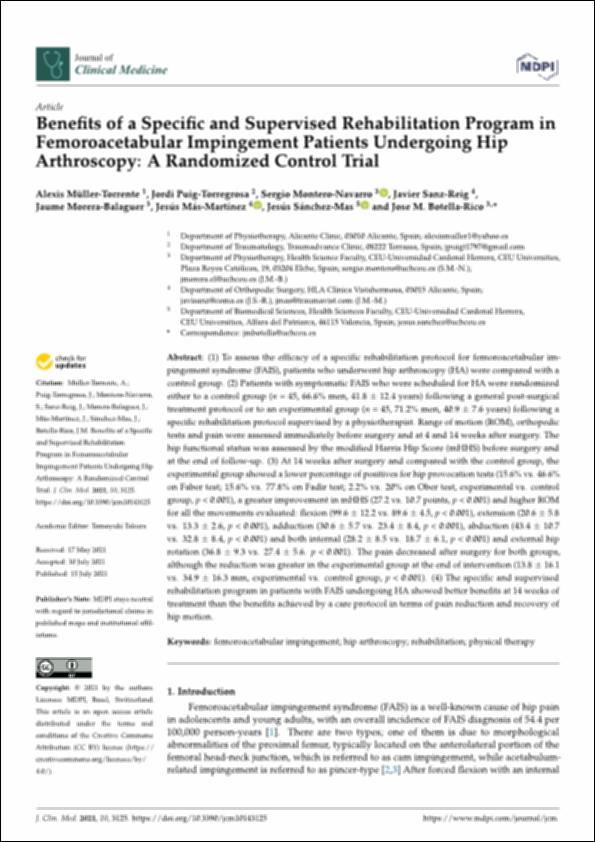Please use this identifier to cite or link to this item:
http://hdl.handle.net/10637/13670Benefits of a specific and supervised rehabilitation program in femoroacetabular impingement patients undergoing hip arthroscopy : a randomized control trial
| Title: | Benefits of a specific and supervised rehabilitation program in femoroacetabular impingement patients undergoing hip arthroscopy : a randomized control trial |
| Authors : | Müller Torrente, Alexis Puig Torregrosa, Jordi Montero Navarro, Sergio Sanz Reig, Javier Morera Balaguer, Jaime Vicente Más Martínez, Jesús Sánchez Mas, Jesús Manuel Botella Rico, José Martín |
| Keywords: | Hip joint - Rehabilitation.; Femoroacetabular impingement syndrome - Physical therapy.; Arthroscopy.; Cadera - Rehabilitación.; Artroscopia.; Síndrome de pinzamiento femoroacetabular - Fisioterapia. |
| Publisher: | MDPI |
| Citation: | Müller-Torrente, A., Puig-Torregrosa, J., Montero-Navarro, S., Sanz-Reig, J., Morera-Balaguer, J., Más-Martínez, J., Sánchez-Mas, J. & Botella-Rico, J.M. (2021). Benefits of a specific and supervised rehabilitation program in femoroacetabular impingement patients undergoing hip arthroscopy: a randomized control trial. Journal of Clinical Medicine, vol. 10, i. 14 (15 jul.), art. 3125. DOI: http://dx.doi.org/10.3390/jcm10143125 |
| Abstract: | (1) To assess the efficacy of a specific rehabilitation protocol for femoroacetabular impingement syndrome (FAIS), patients who underwent hip arthroscopy (HA) were compared with a control group. (2) Patients with symptomatic FAIS who were scheduled for HA were randomized either to a control group (n = 45, 66.6% men, 41.8 12.4 years) following a general post-surgical treatment protocol or to an experimental group (n = 45, 71.2% men, 40.9 7.6 years) following a specific rehabilitation protocol supervised by a physiotherapist. Range of motion (ROM), orthopedic tests and pain were assessed immediately before surgery and at 4 and 14 weeks after surgery. The hip functional status was assessed by the modified Harris Hip Score (mHHS) before surgery and at the end of follow-up. (3) At 14 weeks after surgery and compared with the control group, the experimental group showed a lower percentage of positives for hip provocation tests (15.6% vs. 46.6% on Faber test; 15.6% vs. 77.8% on Fadir test; 2.2% vs. 20% on Ober test, experimental vs. control group, p < 0.001), a greater improvement in mHHS (27.2 vs. 10.7 points, p < 0.001) and higher ROM for all the movements evaluated: flexion (99.6 12.2 vs. 89.6 4.5, p < 0.001), extension (20.6 5.8 vs. 13.3 2.6, p < 0.001), adduction (30.6 5.7 vs. 23.4 8.4, p < 0.001), abduction (43.4 10.7 vs. 32.8 8.4, p < 0.001) and both internal (28.2 8.5 vs. 18.7 6.1, p < 0.001) and external hip rotation (36.8 9.3 vs. 27.4 5.6. p < 0.001). The pain decreased after surgery for both groups, although the reduction was greater in the experimental group at the end of intervention (13.8 16.1 vs. 34.9 16.3 mm, experimental vs. control group, p < 0.001). (4) The specific and supervised rehabilitation program in patients with FAIS undergoing HA showed better benefits at 14 weeks of treatment than the benefits achieved by a care protocol in terms of pain reduction and recovery of hip motion. |
| Description: | Este artículo se encuentra disponible en la siguiente URL: https://www.mdpi.com/2077-0383/10/14/3125 Este artículo pertenece a la sección "Orthopedics". |
| URI: | http://hdl.handle.net/10637/13670 |
| Rights : | http://creativecommons.org/licenses/by/4.0/deed.es |
| ISSN: | 2077-0383 (Electrónico) |
| Issue Date: | 15-Jul-2021 |
| Center : | Universidad Cardenal Herrera-CEU |
| Appears in Collections: | Dpto. Enfermería y Fisioterapia |
Items in DSpace are protected by copyright, with all rights reserved, unless otherwise indicated.


